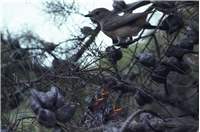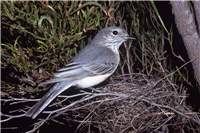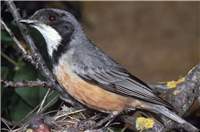Family
Pachycephalidae
Genus
Pachycephala
Species
rufiventris
Threats/Control Methods - Regional
Land clearing and urban development are the greatest threats to this species, as the whistlers depend on good vegetation coverage and species biodiversity in their woodland habitat.
Threats/Control Methods - Local
The biodiversity of local reserves is under threat from weed infestations, aggressive urban birds such as Noisy Minors (Manorina melanocephala ) and free roaming domestic pets.
Local/Urban Actions
This species will visit suburban areas close to nature reserves if gardens include thick vegetation layers of trees, shrubs and ground cover. Collecting firewood from local reserves is discouraged. Domestic Cats (Felis catus) are best provided with a stimulating indoor environment and a cat run or enclosure, to minimise the threat to birds.
Common Names
Rufous Whistler, Rufous-breasted Whistler, Rufous-breasted Thickhead, Echong, Mock Whipbird, Thunderbird
Distinguishing Features
The Rufous Whistler is 16-17.5 in size and is most obvious in spring and early summer, when male birds sing loudly and bob about wildly. The head, back, wings and tail are grey, and the eye is red. Male underparts are a rusty-orange colour, with a white throat contained with a black band from the beak, running across the eye and across the chest. Female underparts are pale with dark streaks, as is the throat and face. Young birds are paler and young males lack the black band.
Survey Techniques
Call and visual identification.
Species Call
Up to 35 loud, rapid, ringing notes without pause, or a high, thin call with a whip-crack.
Similar Species
The female bird may easily be confused with the female Golden Whistler (Pachycephala pectoralis ) due to the similar size, shape and pale colouring. The Golden species lacks the streaks, red eye and is more olive in colour. The similarly coloured Olive Whistler (Pachycephala olivacea ) is larger, lacks the black band and has an olive-brown back.
Distribution
This species is found across all of mainland Australia, excluding only the most arid regions. It is also found in New Caledonia.
Country of Origin
Australia
Conservation (Pet/Pest) Status - Regional
The population numbers have decreased significantly to one tenth of 1981 numbers (COG).
Conservation (Pet/Pest) Status - National
Secure, not listed under the EPBC Act 1999.
LSCCES Population
Some birds were recorded at the ANBG and CSIRO.
Associated vegetation community
The Rufous Whistler inhabits open eucalypt forest, woodland, mallee, vegetation along rivers and suburban gardens.
Limiting Resources
This species relies on a natural bush habitat with many vegetation layers including trees, shrubs, logs and ground cover. A biodiverse range of small species needs to be available as a food source. Habitat areas should ideally be free from both feral and domestic cats (Felis catus).
Breeding
The breeding season runs from September to February, with up to two broods in a season. This species builds a thin, fragile open cup of small twigs and grass, placed about 5m from the ground on the forked branches of a tree or shrub. Both parents incubate the 2-3 brown spotted eggs for 13 days. The young spend about 11 days in the nest.
Behaviour
This species forages carefully for food individually or in pairs, moving through the upper shrub layer or tree canopy. In the breeding season, male birds sing loudly and continuously, bobbing, bowing and chasing rival males.
Functional Group
Food Species
The Rufous Whistler mainly eats insects and other small invertebrates, however it will occasionally eat small reptiles and frogs or small mammals and birds.
Predators
Domestic and feral cats (Felis catus) will predate the Rufous Whistler. The bird itself will also eat small birds.
Interesting Fact
The nest of the Rufous Whistler is so thin that the eggs can sometimes be seen through the nest from below.
References - (reader suitability of references, P=Primary teachers, S=Secondary students, T=Tertiary students and researchers)
Books:Freudenberger, D. 2001. Bush for the birds: Biodiversity enhancement guidelines for the Saltshaker Project, Boorowa, NSW. Consultancy report to Greening Australia ACT and SE NSW Inc. CSIRO Sustainable Ecosystems. Canberra. S, T
Morcombe, M. 2000. Field Guide to Australian Birds. Steve Parish Publishing. Archerfield. Australia P, S, T
Schodde, R. and Tideman, S. (eds) 1990. Reader's Digest Complete Book of Australian Birds (2nd Edition). Reader's Digest Services Pty Ltd. Sydney. P, S, T
Taws, N. et al. 2001. Bringing Birds Back: A Glovebox Guide for Bird Identification and Habitat Restoration in ACT and SE NSW. Greening Australia ACT and SE NSW Inc. P, S, T
Veerman, P. 2003. Canberra Birds: A report on the first 21 years of the garden bird survey. Philip Veerman and Canberra Ornithologists Group. Canberra. S, T
Internet: Birds in Backyards. 2006. [online]. Available at:http://www.birdsinbackyards.net P, S, T
Canberra Ornithological Group (COG). 2004. Birds of Canberra Gardens. COG and the ACT Department of Urban Services. [online]. Available at:http://garden.canberrabirds.org.au/ P, S, T
Online Publications:Nix, H. and Cunningham, R. 2006. Birds of the Lower Sullivans Creek Catchment, Canberra ACT. Prepared for the Life in the Suburbs project using data from the Lower Sullivans Creek Catchment Ecological Survey (LSCCES). Australian National University. Canberra. [online]. Available at: http://www.lifeinthesuburbs.com.au/category.php?id=65 S, T
Olsen, P. et al. 2005. The State of Australia's Birds 2006: Invasive Species. Supplement to Wingspan 16:4. Birds Australia. [online]. Available at: http://www.birdsaustralia.com.au/soab/SOAB2006.pdf S, T



 Top
Top Top
Top